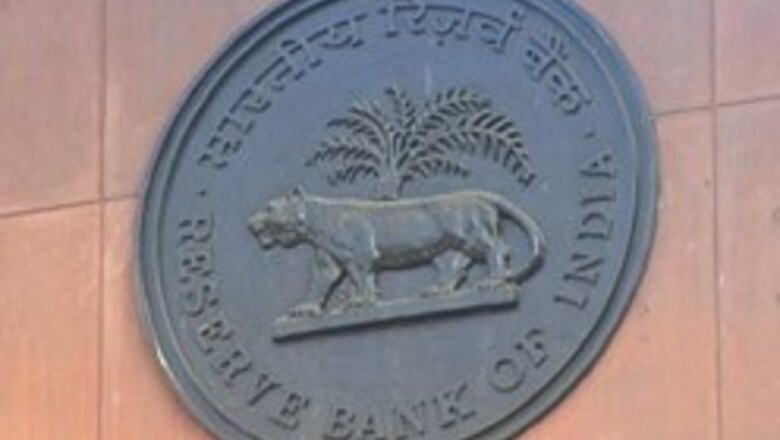
views
New Delhi: Experts though remain optimistic over sustainability of strong economic growth in India in the long run, they say RBI might still increase the CRR rate to tighten further the noose on liquidity.
Shankar Sharma of First Global and Ritu Kochhar, MD & India Economist Bear Stearns believe there are several factors that indicate a possible rate hike by the RBI in the near-future, reports moneycontrol.com.
Q: This has been one long and big global party, how long do you see it continuing?
Ritu Kocchar: There is a lot of liquidity in the market right now and most of the markets have recovered from the February sell off that we have seen.
The thing is that you are going to see some volatility whenever there are changes and expectations of what these different Central Banks are going to do regarding interest rates. So you hear about China putting some restrictions and there is sell off for a while and I think this would continue till you start seeing some major reversal; not like a long-term reversal, but volatility in EM flows and I think one of the triggers could be possibly a rate hike by the Fed or further rate hikes by the RBI or the Public Republic Bank of China.
So I think these are some of the things that probably could cause volatility; till such time I think a plentiful liquidity will continue to drive these markets.
Q: For next four-eight weeks, you think there is anything, which could shake off these benign liquidity condition just in the near foreseeable future?
Ritu Kocchar: In the near future, I do not see anything that is going to shake the markets at this point of time.
But like I said, it is all about changes and expectations of monetary tightening by Central Banks and that would also depend on the data that comes out. So you have the unemployment figures for the US today and if they are relatively strong which we expect, I think that could possibly force your expectations that you know; the Fed does have room where growth is stable and they could go ahead with the rate hike, but given that inflation numbers right now are pretty benign for the US at least, maybe that would not happen for today at least.
But I think unemployment in the US is also going to become a key variable. Next three-four weeks, I do not see anything much. But it is unemployment which I think will now become a key variable, which would improve growth perceptions within the US and inflation continues to remain a concern even though we had seen benign numbers in the last one-two months for the US.
PAGE_BREAK
Where the markets take out the Fed rate cuts that they have priced in, I think that itself could probably be a trigger.
Q: What is the view on India then, are we pretty much linked to what is happening globally or do you think India may move in a different kind of a tangent compared to what global markets are doing?
Shankar Sharma: I think the world has largely moved on and left the US really behind.
Hence, we think that it is pretty much the tail wagging the dog rather than the other way round that you will keep seeing in markets globally rather than what the US does and what the US Fed thinks; determining how global stock markets behave because in general, we have kind of understood that the Fed really does not have much clue about what is going on in the US itself.
So historically, we saw that from Greenspan days, when alternatively they would talk about deflation and inflation. So I kind of stopped watching the Fed a long time back because they are all over the place, saying everything. So assuming some scenario works out, they will say that okay; this is the scenario we kind of were banking on.
By and large, I think the world has wisened up to that. Euro zone is in a different league altogether in terms of growth rates. Asia is doing fine; India has been just smoking hot as we can see from the GDP numbers. US is absolutely tepid.
So clearly, let us forget about the US for a while. Let us focus on where the growth in the world is and that is Euro Zone and Asia. And I think by and large, these markets are looking just fine.
The other thing is that the technical factor that is playing itself out in markets globally is that markets are not taking out their highs conclusively.
They are kind of struggling; even India has struggled its way to this situation. Lately, they are not fluent, they do not kind of come very often and it is like grading through molasses.
So India has reached there, sold off, reached there, sold off. So you are seeing a kind of a sticky situation developing. Even the US whilst at its highs, it is not having conclusive unbroken days of advances. So you have a stop and start market, which is not painting a very pretty picture.
Just for the near-term, I am not saying anything serious happens on six-month basis. But our take is that you might see sharp sell offs in the market in the weeks ahead. Global wall has actually declined again to fairly low levels. We think that has headed for a spike up, it could happen next week, it could happen three weeks from now but I think it is definitely in the slot for a big spike up in global wall, which we think, will obviously drive markets down.
That is a basic short-term call on markets. Overall we think the environment on equities looks just fine. Not a big deal of concern on growth rates anywhere we see in Asia or even in Euro Zone. Things are okay on a six-months basis, but not so okay on a six weeks’ basis.
Q: How did you read the GDP numbers which came in this week because they were taken with a lot of optimism, 9.4% figure, what kind of estimates would you put on that base for this year then?
Ritu Kocchar: Yes, 9.4% is very strongest in nineteen years but more importantly; it comes after three years of above average, above 8% average growth rate for the last three years. So very good numbers there and I think a lot of this is being driven by host of factors on infrastructure building, on capacity expansion, improving competitiveness in businesses, increasing credit penetration within India and strong demand that we are seeing from rising incomes and wages.
These factors will sustain a strong growth in India in the long run. But for the next year, the RBI has already accelerated its rate hikes earlier in the year and I think that they might still actually increase the CRR, maybe even lending our rates another 25 bps.
Global monetary tightening is on its way; that is happening and that could lead to some slowdown in terms of global growth, which could impact exports. Plus we are seeing a very sluggish reform momentum in India and we have not seen domestic policy triggers for growth in recent times.
I think these factors could actually slow GDP in India a little bit and more around the 8% level for the next year. So, yes; very strong growth there and even though it is going to be around 8% and still probably be the second fastest growing country in the world. So definitely, good numbers out there.
PAGE_BREAK
Q: Do you echo the concerns that given the kind of ample liquidity which is seen in the market right now, reflected in the call rates et cetera, you can see another rate move or a tightening move from the Reserve Bank? Do you think that might dent back sentiment or even rate sensitives?
Sharma: You can’t rule that out. I would say that on the balance I think they have done just fine. I think the inflation sorts of concerns have weighted quite significantly and to our mind. If they do this - another 25 bps; fine, I mean we can live with that.
The government is not sort of a big borrower of capital ahead of the private sector. They cannot make a case for an uptick in interest rates that can be sustainable. In our sense, it is just an aberration, no more than that. Hence aberration, even if it were to go to another rate hike; to my mind that would not change; at least what we believe in, which is that the rates are going to come down, come down steeply over the next 12 months’ time.
Inflation, again to our mind, I think 5% or 5.2% or whatever it is; that’s fine. We can live with that because given the inflation at the salary levels, most of us can afford to pay a little bit more for a loaf of bread or a pack of biscuits.
But let’s give some money to the farmers because that’s really the vote bank the government really wants to appease. I think inflation is really good for the farmer. I think the government secretly does want the inflation number not to fall too much. So, overall, we are looking at a 5% number in inflation. That is just fine. That is not great worry in terms of financial papers. But that is great for the masses in this country who live off agriculture. I think overall inflation at these levels mean that interest rates just simply cannot move up significantly. If anything, there is a case to be made for reducing them over the next few months.
Q: Would you agree with that that interest rates will come off and we are pretty much close to the peak? How much do you think the already affected interest rates could dent earnings growth or even economic growth?
Kochhar: I think inflation numbers have abated and given that the rupee has also appreciated on the year-on-year effect, the numbers wouldn’t lower. But I think as such global commodity prices remain high, domestically there are supply constraints within the economy. So you wouldn’t see inflationary pressures as such going down.
Food prices do affect farmers. Yes, a lot of us in middle, upper income brackets can probably afford to pay extra. But for the farmers it does put a squeeze on their consumption expenditure. So I think that would be an issue for the government especially given that you have another state elections this year, another 9 state elections next year and then the central elections.
So, given these situations plus you are seeing strong inflows into the rupee and we don’t have enough tools of sterilization. The RBI does not have enough tools of sterilization. It has used the CRR hike in the past and I think they could use that again if need be for sterilizing, mopping up the liquidity.
So I don’t think we are done with interest rate hikes. I think we could see another 50 basis points. Like I said in the CRR, another 25 basis points in the lending rates, plus central banks would probably still - say ECB, Bank of Japan, they are still moving higher. We have expectations of another rate hike by the Fed as well and I think these could make way for rate hikes by other central banks including the RBI as well.
Q: How do you read the rupee because that has pegged back a lot of our exporting sectors out here like technology? Are you in the camp which believes that the rupee needs to now move back to 42-43 or do you see the appreciation continuing even if it stops for the near term?
Kochhar: Yes, near term, most of the upside is limited and I think there is a bigger risk of a downside likely being triggered by an emerging market and including an India sell off.
I think the RBI would continue to intervene at these levels through a combination of government securities, CRR, and India is the second fastest growing country in the world. So once things settle down, even after an EM sell off, I think flows into India will remain strong. I don’t expect inflation pressures to abate significantly at this point of time.
So I think given those situations, you would probably see later on in the year, the rupee start appreciating again. I think the rupee does have a long-term appreciation trend. It really is the willingness of the RBI whether it is going to be gradual or faster, their willingness to intervene in the markets or finding out a more long-term solution of how to manage these strong inflows. But I think the rupee has a long-term appreciation trend though in the short term a sell is probably what is going to happen.
PAGE_BREAK
Q: Just to come back to one bit of news this week, you track aviation and you have Deccan in your list of recommendations. How has the whole aviation space changed after this deal and what do you do with stocks like Deccan and Jet now?
Sharma: Go and buy them. Our view especially on the low-cost carriers was that, at a certain price, they had become very, very viable as a stock investment. And our sense was that, that was really the space where a lot of capital would be going in rather than the full-service carriers, because India is still a poor country. India still needs low cost transportation. That, kind of fit the overall bill if you look at the demographics of the country. So, our sense was it was Rs 85 on Deccan or Rs 90 or whatever price it was when it turned bullish.
To our mind, that was an absolute throwaway price and you really couldn’t see much downside. Clearly, what has happened subsequently was again something that was largely anticipated that there would be consolidation; the companies had become quite cheap, so there would be strategic buyouts. Nothing that we see actually surprises us. It is our take that now, the industry is well-consolidated. So you have Jet and Sahara on the one hand and you have Kingfisher and Deccan on the other hand. SpiceJet and GoAir et cetera are kind of smallish airlines.
These two guys will basically determine how the industries pricing policy would shape up, which is if anything to go by in terms of the press announcements, you are looking at stable to improving pricing scenario on a yield basis on most of these carriers. Things can only get better from hereon, fairly optimistic.
Q: DLF opens next week, what is your take on that issue and real estate in general?
Shankar Sharma: If you keep benchmarking DLF to Unitech, then sometimes Unitech looks cheap or DLF looks expensive or vice-versa.
To my mind, whether overall they are cheap is or not is another matter altogether. Our sense is; yes, India does need a few large listings on the real estate side because we also do want listed companies going buzzed when the market turns - just like most of Asia, from time to time does have these things. So we need to create a basket of companies eventually. And as a fund manager once told me that a lot of these economies create these companies because they want to create a basket of shorts when the outlook turns dim on the economic front.
So in India, we have these cyclical interest rates sensitives growing as a part of the marketcap of the overall country and I can say that they are on the top of the market - they are going to take away a lot of the capital, they are going to execute well for a few years.
But to kind of pay the valuations that we are talking about here, we have to be really brave or we have to be just taking a big macro bet that since this sector is under represented, we are just going to take a pure sector bet It does not matter whether it is Unitech or DLF.
So it is more an article of faith. Just on pure numbers, they absolutely look off charts in terms of valuations. There is no doubt about it. So like I said, that does not mean that the stocks will not fly off once they list.
We have seen stranger things happen in the markets. But our view is largely circumspect, not just because of the valuation, but also because real estate is never a smooth run.
There are lots of bumpy sort of patches you encounter while the markets do not typically like that. Which means a year down the road, they could well be trading at lower multiples than at which they have been floated just now.
Q: What is your overall emerging market equity call right now, for one month, three months, six months horizon?
Ritu Kocchar: For us right now, because of plentiful liquidity in the markets that we are continuing to see, we think foreign equities in general will outperform.
US equities in growth are becoming much more diverse and countries like India, China are actually driving a big part of the growth as well and you are seeing Japan do well, Europe has been doing much better.
So as such, we think emerging markets are likely to do better than US equities near-term and even long-term. But you are going to see periods of volatility whenever we in the camp of the Fed still hiking rates and global liquidity tightening and whenever that happens, you are going to see bouts of volatility as people reprice risks. And so in such case, emerging markets; right now sovereign spreads are very tight and you will probably see some widening at that point. So you are going to see an upturn in emerging markets in general but with bouts of volatility.
Source:Moneycontrol.com















Comments
0 comment